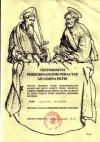Greetings from Santiago
Due to popular demand here is another dilemma - again it is real.
An enquiry is made to the Pilgrims´ Office on behalf of a disabled person. It has been their long -held ambition to make a pilgrimage to Santiago and to recieve the Compostela. The nature of their disability is now such that they have to make the pilgrimage with motorised transport. They will also have a back up vehicle carrying essential supplies etc. When they reach Santiago will they recieve the Compostela?
Due to popular demand here is another dilemma - again it is real.
An enquiry is made to the Pilgrims´ Office on behalf of a disabled person. It has been their long -held ambition to make a pilgrimage to Santiago and to recieve the Compostela. The nature of their disability is now such that they have to make the pilgrimage with motorised transport. They will also have a back up vehicle carrying essential supplies etc. When they reach Santiago will they recieve the Compostela?



















